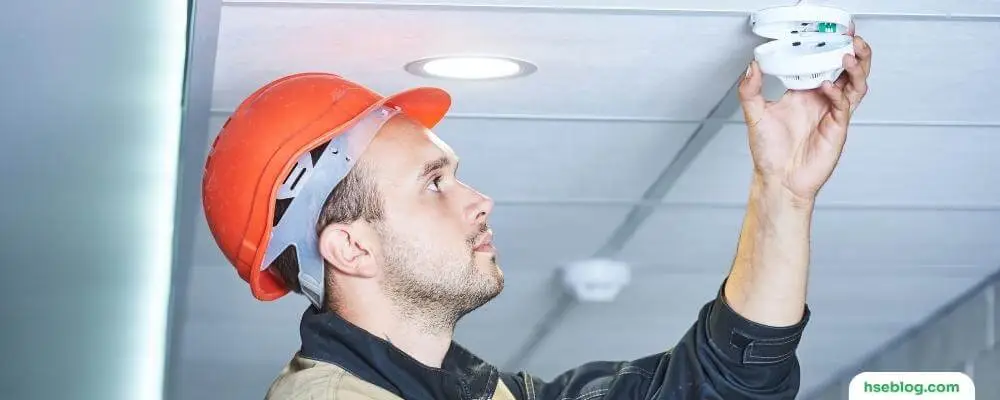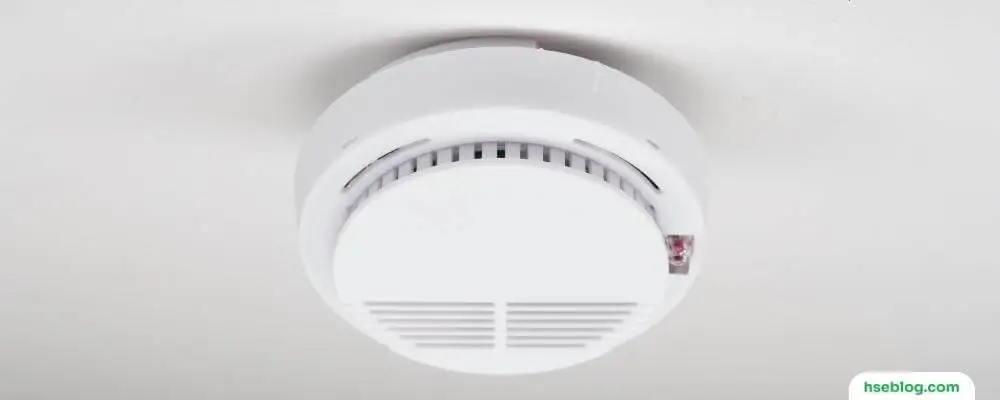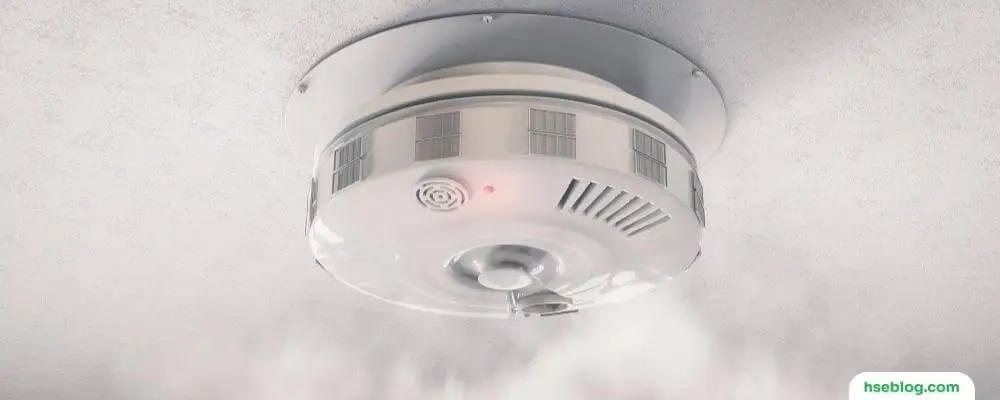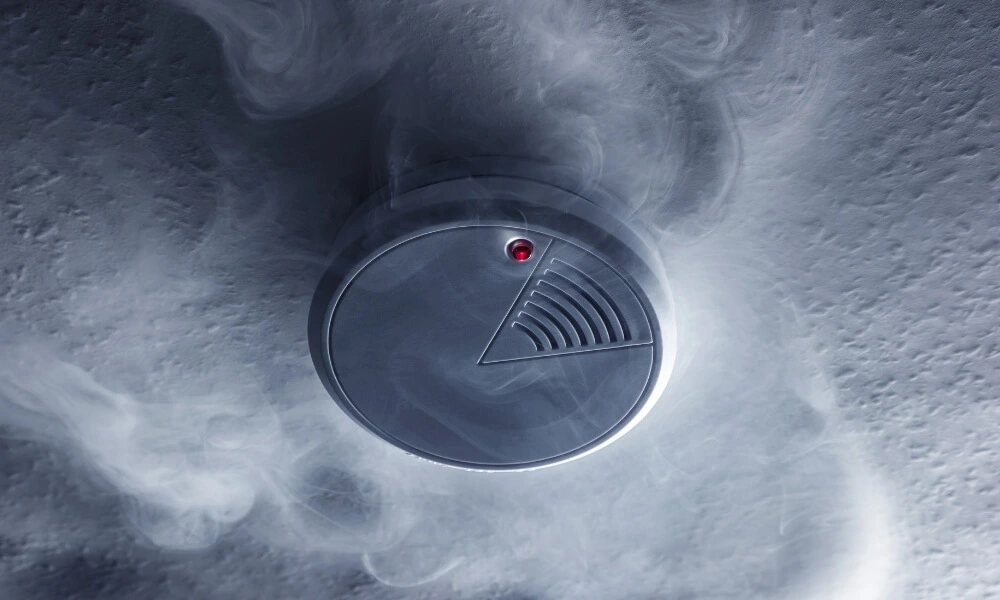Few devices are as essential or effective as smoke detectors when safeguarding your home or workplace from the fire threat. These small, unassuming devices are your first line of defense, sounding the alarm at the earliest signs of danger and providing precious time to evacuate safely. But have you ever wondered how these life-saving gadgets work? Or that there are different types of smoke detectors, each designed to detect specific types of fires?
In this blog post, we’ll look in-depth at the world of smoke detectors, exploring the different types available and demystifying the technology behind them. Whether you’re looking to install a smoke detector system in your home or workplace for the first time, considering an upgrade, or are just curious about the tech safeguarding your home or workplace, this guide has you covered. Join us as we delve into the fascinating world of smoke detectors, the unsung heroes of home safety.
What Is a Smoke Detector?
A smoke detector is a device that senses the presence of smoke in the environment and raises an alarm to alert people about a potential fire. This warning can save lives and minimize property damage by allowing rapid response to the fire. Smoke detectors are commonly found in homes, workplaces, schools, and other places where people gather.
There are two primary types of smoke detectors:
- Ionization smoke detectors: These detectors contain a small amount of radioactive material that ionizes the air, creating a current within the detector. When smoke enters the detector, it disrupts this current, which triggers the alarm.
- Photoelectric smoke detectors: These detectors use a light source (a LED) and a light sensor. When smoke enters the detector, it scatters the light beam, causing the light to hit the sensor and trigger the alarm.
Some smoke detectors use a combination of these technologies to increase their accuracy. Furthermore, there are also more advanced detectors that can also sense carbon monoxide and other gases.
Smoke detectors are usually powered by batteries or are hard-wired into a building’s electrical system. Many also have a backup battery to ensure they continue working during a power outage. These devices ‘ regular testing and maintenance (e.g., replacing batteries) is crucial for their effectiveness.

Different Types Of Smoke Detectors and How to Do They Work
There are several types of smoke detectors, each with strengths and limitations. Here are the most common types:
1. Ionization Smoke Detectors
Ionization smoke detectors are one of the most common types of smoke detectors used in residential and commercial settings due to their ability to quickly detect small smoke particles from fast-flaming fires.
How Ionization Smoke Detectors Work:
These detectors operate based on the principles of ionization. Inside each detector, a small amount of radioactive material, usually Americium-241, is placed between two electrically charged plates. The radioactive material emits alpha particles, which ionize the air molecules in the space between the plates, knocking electrons off the air molecules and creating positive air ions and free electrons.
This ionization process results in a small but stable current flowing between the two plates because of the movement of the ions and electrons.
Detection Process:
When smoke enters the detector, the particles attach themselves to the charged ions. This reduces the ions’ mobility and disrupts the current between the plates. When the current drops below a certain threshold, the alarm is triggered.
Ionization detectors are particularly good at detecting smoke from fast-flaming fires that produce small smoke particles. These types of fires consume combustible materials quickly and can spread rapidly. Examples include paper burning in a wastebasket or a kitchen grease fire.
Advantages and Disadvantages:
The advantage of ionization smoke detectors is their sensitivity to small, less visible smoke particles. They can quickly alert occupants when a fast-flaming fire occurs, providing crucial seconds for evacuation.
The main disadvantage of ionization detectors is that they are sometimes too sensitive. They can give false alarms from cooking smoke or steam, leading some people to disable them, which is a serious safety risk. They are also less effective at detecting larger smoke particles often produced by slow, smoldering fires, such as a cigarette smoldering on a couch.
Despite these disadvantages, ionization smoke detectors remain critical to home and business safety because they detect rapid flaming fires effectively. However, they are often combined with other detectors for a more comprehensive fire detection system.
2. Photoelectric Smoke Detectors
Photoelectric smoke detectors, also known as optical smoke alarms, are another common type of smoke detector. They’re particularly effective at detecting slow, smoldering fires which produce larger smoke particles.
How Photoelectric Smoke Detectors Work:
A photoelectric smoke detector uses a light source, usually a light-emitting diode (LED), and a light sensor (photodiode or photoelectric cell). The key to the detector is that the light source and sensor are placed at a certain angle in the sensing chamber so that under normal conditions (no smoke), light from the LED does not directly hit the sensor.
Detection Process:
When smoke enters the chamber, the smoke particles scatter the light beam, causing some light to strike the sensor. When the sensor detects this scattered light, it triggers the alarm. The amount of light hitting the sensor increases with the amount of smoke, and the alarm is typically triggered when the light hitting the sensor reaches a certain threshold.
Advantages and Disadvantages:
Photoelectric smoke detectors can detect larger smoke particles typically produced by slow, smoldering fires, such as those caused by unextinguished cigarettes or electrical fires starting within walls. These fires can smolder for hours before erupting into flames, and the photoelectric smoke detector can provide an early warning.
One of the main advantages of photoelectric smoke detectors is that they are less likely to give false alarms from cooking than ionization detectors. This means they can often be installed closer to kitchens. However, they’re typically less responsive than ionization detectors to fast-flaming fires that produce smaller smoke particles. This doesn’t mean they won’t detect such fires, but there may be a slight delay compared to ionization detectors.

3. Dual Sensor Smoke Detectors
Dual-sensor smoke detectors, as the name implies, combine the technologies used in ionization and photoelectric smoke detectors to provide broader fire detection coverage.
How Dual Sensor Smoke Detectors Work:
Dual-sensor smoke detectors have two separate sensor chambers inside the same unit: one for ionization detection and one for photoelectric detection. The ionization sensor detects small particles typical of fast-flaming fires, while the photoelectric sensor is effective at detecting larger particles typical of slow, smoldering fires.
Detection Process:
The detector monitors the signals from both sensors and triggers the alarm when either sensor detects a significant change, indicating smoke or fire. This means that whether a fire is fast and flaming or slow and smoldering, the dual-sensor detector should be able to detect it quickly and sound an alarm.
Advantages and Disadvantages:
The primary advantage of dual-sensor smoke detectors is their versatility. These detectors provide comprehensive coverage for fast-moving, flaming, and slower, smoldering fires by integrating ionization and photoelectric technologies. This makes them an excellent choice for general use in many home or business areas.
The disadvantage of dual-sensor smoke detectors is that they can be more expensive than single-sensor detectors. However, the additional cost is often justified by the improved safety they provide.
Another minor disadvantage is that these detectors may still be susceptible to false alarms from cooking smoke, steam, or other non-fire sources of small particles that can trigger the ionization sensor, similar to standalone ionization detectors.
4. Heat Detectors
Heat detectors are devices used in fire detection systems triggered by increased temperature. They aren’t technically classified as smoke detectors but play an important role in fire detection and safety.
How Heat Detectors Work:
Heat detectors typically operate on one of two principles: rate-of-rise detection or fixed-temperature detection.
- Rate-of-Rise (ROR) Heat Detectors: These detectors respond when the temperature increases rapidly over a short period. They contain a thermocouple or similar device that measures temperature change. The detector triggers an alarm if the temperature rises too quickly (regardless of the starting temperature).
- Fixed-Temperature Heat Detectors: These detectors are triggered when the temperature reaches a predetermined level, typically around 135-165 degrees Fahrenheit (57-74 degrees Celsius). They usually use a eutectic alloy that melts or a bi-metallic element that bends at a fixed temperature to complete an electrical circuit and trigger the alarm.
Some heat detectors incorporate both rate-of-rise and fixed temperature detection for added responsiveness and reliability.
Where They Are Used:
Heat detectors are often used in environments where smoke detectors may give false alarms or may not function optimally due to ambient conditions. These include kitchens (where smoke and steam from cooking can trigger false alarms), garages, boiler rooms, and dusty or humid environments.
Advantages and Disadvantages:
Heat detectors have the advantage of being robust and less likely to generate false alarms in dusty, steamy, or smoky environments where smoke detectors might be too sensitive.
The main disadvantage of heat detectors is that they can be slower to respond than smoke detectors because they require a significant heat increase or a high temperature to trigger. They may not provide early warning of fires that produce a lot of smoke but little heat. Therefore, they are usually not recommended as the sole type of fire detection device in residential settings but as part of a larger fire detection system.

5. Smoke Detectors with Carbon Monoxide Detectors
Smoke detectors with built-in carbon monoxide (CO) detectors are combination devices designed to alert you to smoke from fires and dangerous levels of carbon monoxide gas.
How They Work:
These detectors combine the technologies used in smoke detectors (ionization, photoelectric, or both) with those used in carbon monoxide detectors. Carbon monoxide detection is typically achieved through either biomimetic, metal-oxide-semiconductor, or electrochemical technologies:
- Biomimetic Sensors: These sensors contain a gel that changes color when it absorbs CO. The detector senses the color change and triggers the alarm.
- Metal-Oxide-Semiconductor Sensors: Inside the sensor, a silica chip’s electrical resistance lowers when it comes in contact with CO. The detector senses this change and triggers the alarm.
- Electrochemical Sensors: These are considered the most accurate. They contain an electrolyte solution and electrodes. When CO comes in contact with the solution, a chemical reaction triggers the alarm.
Advantages and Disadvantages:
The primary advantage of combination smoke and CO detectors is their convenience. They provide two important safety functions in one device, reducing the number of individual detectors you need to install and maintain.
Another advantage is that, like standalone CO detectors, they can detect CO gas from any source, not just fires. This includes faulty furnaces, water heaters, stoves, or blocked chimneys, making them crucial safety devices for any home or workplace.
The disadvantage of combination detectors is that they might not offer the same level of sensitivity and specificity as standalone detectors. For example, the best place to install a smoke detector (on the ceiling) is not always the best for a CO detector (near the breathing level). In addition, smoke and CO detectors may have different lifespans, so one function may expire before the other.

How to Choose the Right Smoke Detector
Choosing the right smoke detector involves considering your home or workplace’s layout, lifestyle, and the risks you may face. Here are some factors to consider when choosing a smoke detector:
- Type of Detector: As we’ve discussed, smoke detectors come in different types, including ionization, photoelectric, and dual sensor models. Ionization detectors are best at detecting flaming fires, while photoelectric detectors are more effective at catching smoldering fires. Dual sensor models offer both capabilities, providing comprehensive coverage.
- Combination Detectors: Some models also include carbon monoxide (CO) detectors, which can be especially useful in homes or workplaces with fuel-burning appliances or attached garages.
- Power Source: Smoke detectors can be hard-wired into your home or workplace’s electrical system, battery-operated, or offer a combination of both (hard-wired with a battery backup). Hard-wired models with battery backups are generally considered the most reliable.
- Interconnectivity: Some smoke detectors can be interconnected, so they all do when one alarm sounds. This can be especially important in the home or workplace, ensuring everyone is alerted no matter where they are. Hard-wired detectors commonly find this feature, but some wireless models can be interconnected.
- Testing and Silence Feature: Look for a smoke detector with a test button to ensure it’s working correctly. Some models also feature a silence button that can quiet a non-emergency alarm quickly, which can be handy for nuisance alarms (like those triggered by cooking smoke).
- Certification: Ensure that the smoke detector you choose is certified by a recognized testing laboratory, which indicates it meets certain standards of effectiveness.
- Lifespan and Maintenance: Most smoke detectors must be replaced every 10 years. Some models have sealed 10-year batteries that don’t require replacement during the detector’s life. Remember, all smoke detectors need regular testing to ensure they are working properly.
- Special Features: Some detectors come with extra features, such as lights to aid in escape, voice alarms that can be less frightening to children, or compatibility with smart home systems for remote alerts and testing.
- Installation: Think about where you will install your detectors. Installing smoke detectors in every bedroom, outside each separate sleeping area, and on every level of the home or workplace, including the basement, is recommended. Installing CO detectors near sleeping areas and on each level of your home is best.
Choosing the right smoke detector depends on your unique circumstances and needs. It’s a good idea to consult a local fire department or a fire safety professional to ensure you make the best choice for your home or workplace.

Installation and Maintenance of Smoke Detectors
Proper installation and maintenance of smoke detectors are essential to effectively alert you in case of a fire. Here’s a general guideline on how to install and maintain your smoke detectors:
A. Proper Installation Guidelines:
- Placement: Install smoke detectors in every bedroom, outside each separate sleeping area, and on every level of your home or workplace, including the basements.
- Height: Since smoke rises, detectors should be mounted on the ceiling or high up on the walls, typically 4-12 inches from the ceiling.
- Avoidance Areas: Keep detectors away from windows, doors, or air vents where drafts could interfere with their operation. Also, avoid installing detectors near appliances like stoves or ovens that could lead to false alarms.
- Interconnection: In larger homes, consider using interconnected smoke alarms, so when one alarm sounds, they all do.
B. Regular Maintenance and Testing:
- Testing: Test your smoke detectors at least once a month by pressing the test button, ensuring the alarm sounds.
- Cleaning: Dust and debris can interfere with your smoke detector’s functionality. Use a vacuum cleaner to clean the dust off your smoke detectors regularly.
- Battery Replacement: If your detectors are battery-operated or have battery backups, replace the batteries at least once a year or as soon as the detector chirps to signal a low battery. Some models offer 10-year batteries, which can be a convenient option.
C. Replacement and Disposal:
- Replacement: Smoke detectors should generally be replaced every 10 years from the date of manufacture, not the date of purchase. This date is usually located on the back of the smoke detector.
- Disposal: When it’s time to dispose of a smoke detector, remove the batteries and dispose of them properly. As for the detector itself, check with your local waste disposal facility. Some areas allow you to dispose of detectors with your regular household trash, while others require you to take them to a recycling facility.
Remember, these are general guidelines, and it’s always best to follow the manufacturer’s specific instructions for installing, maintaining, and disposing of your particular smoke detector. You can also consult your local fire department for additional guidance.
Conclusion
understanding the different types of smoke detectors and how they work is a key component of home or workplace safety. Whether it’s an ionization, photoelectric, dual-sensor, heat detector, or a combination smoke and carbon monoxide detector, each serves a vital purpose and offers unique advantages. Choosing the right detector for each area of your home or workplace ensures you can respond effectively to various fires.
However, owning a smoke detector is just the first step. Regular maintenance, testing, and eventual replacement are all crucial to keeping your detectors in working order. By learning about and caring for these devices, you’re investing a valuable investment in your home or workplace safety and your loved ones’ well-being.

